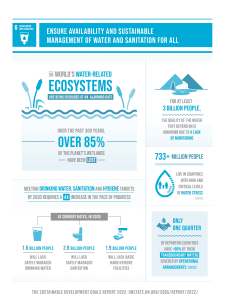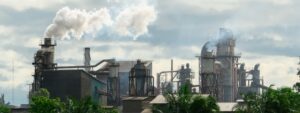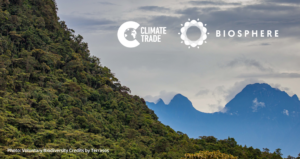March is the month of SDG 6 – clean water and sanitation. Access to safe water is crucial for human health, but do you know how this issue relates to climate change?
After focusing on SDG 5 (gender equality) in February, the United Nations are placing the emphasis on SDG 6 (clean water and sanitation) this month. According to the UN, 2 billion people lived without safely managed drinking water services in 2020. The pressure to solve this problem is real, especially because demand for water is rising due to population growth, urbanization and increasing water needs from the agriculture, industry, and energy sectors.
The Earth’s water sources and reserves are threatened by climate change, but good water management can also play a role in mitigating it. In this article, we explore the relationship between SDG 6 and climate action.
SDG 6 – Clean water and sanitation
Clean water and sanitation is one of the UN’s Sustainable Development Goals (SDGs), which form part of the global 2030 Agenda. The UN estimates that 829,000 people die every year from diseases directly attributable to unsafe water, inadequate sanitation and poor hygiene practices, and this SDG aims to solve this problem.
It consists of six specific targets, five of which are geared towards 2030:
- Achieve universal and equitable access to safe and affordable drinking water for all
- Achieve access to adequate and equitable sanitation and hygiene for all and end open defecation, paying special attention to the needs of women and girls and those in vulnerable situations
- Improve water quality by reducing pollution, eliminating dumping and minimizing release of hazardous chemicals and materials, halving the proportion of untreated wastewater and substantially increasing recycling and safe reuse globally
- Substantially increase water-use efficiency across all sectors and ensure sustainable withdrawals and supply of freshwater to address water scarcity and substantially reduce the number of people suffering from water scarcity
- Implement integrated water resources management at all levels, including through transboundary cooperation as appropriate
The final target was meant to be achieved by 2020, and involved protecting and restoring water-related ecosystems, including mountains, forests, wetlands, rivers, aquifers and lakes.


Water and the climate change threat
Since water is a basic human health need, we would need to solve management, scarcity and hygiene issues even if our climate was stable. But global warming is threatening to turn the world’s water issues into a full-blown crisis. There are several ways that climate change is affecting water on Earth.
Changes in rain patterns
Warming temperatures are leading to more water evaporation, intensifying our planet’s hydrological cycle. This means that rainfall is becoming less frequent, but much heavier.
Scientists predict that extreme precipitation will intensify with global warming over large parts of the globe “as the concentration of atmospheric water vapor which supplies the water for precipitation increases in proportion to the saturation concentrations at a rate of about 6–7% per degree rise in temperature”.
However, the weather is likely to alternate between extreme precipitation and long periods of drought. For example, this winter saw record low rain and snowfall across Europe. As a result, water availability will vary widely throughout the year, oscillating between abundance and scarcity.
Water contamination
When too much rain falls at one time, the soil and plants are unable to absorb it all. This leads to a phenomenon known as “runoff”, whereby excess water drains into nearby rivers, picking up waste and contaminants like fertilizer on the way. This contaminated water ends up in lakes, peatlands, seas and oceans, polluting the entire water supply.
Melting of ice caps
Another famous effect of climate change is the melting of glaciers, ice caps and sea ice. Today, about 10% of land area on Earth is covered with glacial ice (90% in Antarctica and 10% in Greenland). The melting of such a large quantity of ice is leading to a rise in sea levels and a slowdown of currents, on top of releasing more greenhouse gases into the atmosphere.
Desertification
Because climate change is leading to more evaporation and fewer rainfalls, it is partly responsible for the desertification of soils around the world. According to the Intercontinental Panel on Climate Change (IPCC), desertification has already reduced agricultural productivity and incomes and contributed to the loss of biodiversity in some dryland regions. It is also leading to the spread of invasive plants that results in ecosystem services losses.
One of the ways to combat soil desertification is the implementation of regenerative practices in agriculture (a practice sometimes known as carbon farming). The Jari Pará REDD+ Project, for instance, produces food sustainably while reducing GHG emissions in the Brazilian Amazon.
Water management as a climate change solution
As seen above, climate change has a definite negative impact on our planet’s water. This is why finding efficient water solutions that help us preserve the availability and quality of water for all is crucial for climate action.
Access to safe water
Providing people with water that is safe to drink is not only a basic health need – it also leads to a reduction in carbon emissions. That’s because when water isn’t clean, people are forced to boil it before drinking it, often using inefficient open fires that emit CO2. that’s why initiatives like the Sierra Leone Safe Water Project are so important: not only does it reduce the likelihood of water-borne illnesses in the local community, but it also leads to cleaner, less polluted air.
Waste water management
Because climate change increases the risk of water contamination, reducing water pollution becomes even more important. Some projects are using innovative methodology to treat or reuse wastewater coming out of factories, avoiding harmful runoff. For instance, the Carotino Palm Oil Mill Project in Malaysia has installed an anaerobic loop system that covers the factory’s wastewater lagoons, capturing methane that is naturally released from wastewater and turning it into electricity. This electricity is then used to power the palm oil factory and is fed back into the national grid, creating sustainable, circular production.
Cleaning water sources
Finally, since contamination is unavoidable, cleaning the world’s waterways and oceans is indispensable. This project, for example, consists in removing plastic from the Mediterranean sea and transforming it into valuable products.
- SEO Powered Content & PR Distribution. Get Amplified Today.
- Platoblockchain. Web3 Metaverse Intelligence. Knowledge Amplified. Access Here.
- Source: https://climatetrade.com/the-relationship-between-water-and-climate-change/
- :is
- $UP
- 000
- 1
- 2020
- a
- About
- above
- abundance
- access
- According
- achieved
- across
- Action
- address
- affecting
- affordable
- agenda
- Agricultural
- agriculture
- aims
- AIR
- All
- already
- and
- Antarctica
- ARE
- AREA
- around
- article
- AS
- At
- Atmosphere
- atmospheric
- attention
- availability
- avoiding
- back
- basic
- BE
- because
- becomes
- becoming
- before
- between
- Billion
- Brazilian
- by
- CAN
- caps
- Capturing
- carbon
- carbon emissions
- change
- chemicals
- Cleaning
- Climate
- climate action
- Climate change
- co2
- combat
- coming
- community
- concentration
- contaminants
- contributed
- cooperation
- covered
- covers
- Creating
- crisis
- crucial
- cycle
- Degree
- Demand
- Development
- Die
- directly
- diseases
- Drink
- Drought
- earth
- ecosystem
- Ecosystems
- effect
- efficiency
- efficient
- electricity
- eliminating
- Emissions
- emphasis
- ends
- energy
- ensure
- Entire
- equality
- especially
- estimates
- Europe
- Even
- Every
- example
- explore
- extreme
- factories
- factory
- Falls
- famous
- February
- Fed
- final
- finding
- fires
- focusing
- food
- For
- form
- frequent
- from
- geared
- Gender
- GHG
- GHG emissions
- girls
- Global
- global warming
- globe
- Goals
- good
- Grid
- Growth
- Halving
- harmful
- Health
- help
- How
- HTTPS
- human
- ICE
- Impact
- implementation
- important
- in
- Including
- Increase
- Increases
- increasing
- industry
- inefficient
- initiatives
- innovative
- instance
- integrated
- InterContinental
- involved
- issue
- issues
- IT
- jpg
- Know
- known
- Land
- large
- leading
- Leads
- levels
- like
- likely
- local
- Long
- loss
- losses
- Low
- Malaysia
- managed
- management
- materials
- max-width
- means
- methane
- Methodology
- minimizing
- mitigating
- Month
- more
- National
- Nations
- Nature
- Need
- needs
- negative
- number
- oceans
- of
- Oil
- on
- ONE
- open
- palm
- panel
- part
- parts
- paying
- People
- periods
- placing
- plants
- plastic
- plato
- Plato Data Intelligence
- PlatoData
- Play
- Pollution
- poor
- population
- power
- practice
- practices
- pressure
- Problem
- Production
- productivity
- Products
- project
- projects
- protecting
- quality
- quantity
- RAIN
- Rate
- real
- recycling
- reduce
- Reduced
- reducing
- regenerative
- regions
- relationship
- release
- released
- reserves
- Resources
- responsible
- restoring
- result
- Results
- Rise
- rising
- Risk
- Role
- safe
- safely
- Scarcity
- SDGs
- SEA
- Sectors
- Services
- several
- since
- SIX
- Slowdown
- So
- Solutions
- SOLVE
- some
- Sources
- special
- specific
- spread
- stable
- substantially
- such
- suffering
- supply
- sustainable
- system
- Target
- targets
- that
- The
- the world
- Through
- throughout
- time
- to
- too
- top
- towards
- transforming
- treat
- TURN
- Turning
- UN
- United
- united nations
- Universal
- us
- Valuable
- Vulnerable
- Waste
- Water
- Way..
- ways
- Weather
- which
- while
- widely
- will
- Winter
- with
- Withdrawals
- without
- Women
- world
- world’s
- would
- year
- zephyrnet












